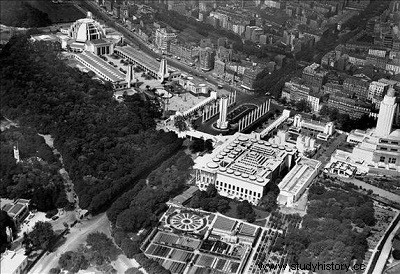
Tunisia is evoked by the home of a wealthy Tunisian. Here is the patio, framed
with orange trees, with the marble basin where the classic water jet sings like the essential accompaniment to the oriental tale, the terrace enclosed by azure moucharabiehs. Behind them will no doubt shine the curious eyes of the owner's many wives. But no, these residents are replaced, in this case, by soldiers of the beylical guard...
Let's cross the more intimate boudoir, called kbou; in the axis of the interior courtyard
, a monumental room exhibits the riches of the Tunisian economy in large diorama panels.
But it's up to through the souks is the swarm of life. Offers from
caouadjis, melodies from snake charmers, insidious proposals from fortune tellers, calls from jewelers, perfume merchants, embroidered leather, brass, ceramics, Kairouan carpets . Here is the souk el-Barka, a small square with columns where the slave market is held, with its Moorish café which serves violet and rose syrups to visitors.
By the ingenious arrangement of dioramas, the paths of the souks lead us to two picturesque corners of Tunis:the rue des Andalous and the place Bab-Souika dominated by the mosque of Sidi-Mahraz, crowned with white domes. On the right, a few steps of a small staircase take us to the terrace of Dar-el-Bey, the beylical palace. A vast panorama 32 meters long by 7 wide evokes before us Tunis at sunset, Carthage, La Goulette, the mountain of the Two Horns.
We travel around the world, while not leaving Vincennes.
Morocco. Let us enter through the door of Rouah, the Bab er-Rouah, of Rabat. We
are in 1912. The room of the Pacification evokes the various stages of the French progression. The settler and the doctor accompany the soldier, and the teacher follows them closely. While waiting for school, the quinine and the packet of bandages are irresistible weapons. Here is the Morocco of the past with the patio of this house in Fez, the Maghzen room and its diorama evoking the sultan leaving the Bab Mansour el-Halery, the door of Mansour the Renegade. A rest room offers archaeologists some vestiges of the famous excavations of Volubilis. A hall of honour, whose vault has the shape of a ship's hull, is devoted to the products of indigenous arts and crafts. A diorama retains visitors. It represents Fez seen from the tomb of the Marinid sultans, with the two old cities and the new city, and the Middle Atlas which dominates them.
Algeria. Its pavilion is a synthesis of all Mediterranean art. It looks like a casino, but in good taste. The Coupole room is decorated by Pierre Devêche. It is a vast rotunda 28 meters high entirely devoted to Algerian agriculture. In the center, a luminous fountain ends in a heap of sculpted grapes. On the walls, surmounting the groups of columns, vast panels evoke vines, cereals, olive trees, fruits. The agricultural products hall, designed by Eugène Corneau, shows samples of grains, oils and perfume plants. And here, in five dioramas executed by artists from the country, or residents of the Villa Abd el-Tif - the African Villa Medici, the main scenes of Algerian agricultural life:harvesting dates, orchards of Mitidja, olive trees of Kabylie .
